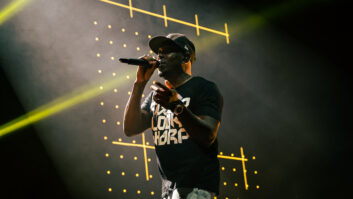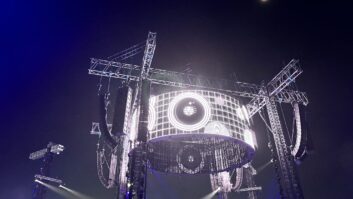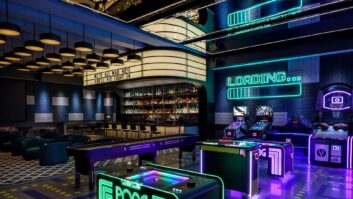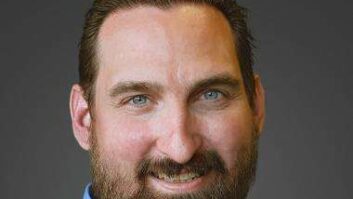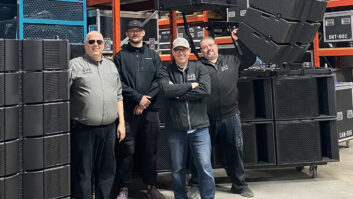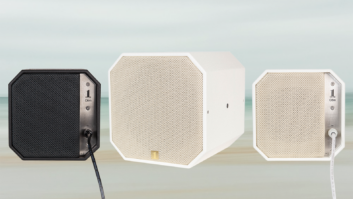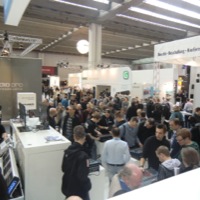
This year’s Prolight + Sound was equally interesting from business and technology angles. Increasing levels of co-operation were evident between different brands, whether owned by the same company or not. In most cases this was so they could present a fuller offering, and it took some companies into previously unexplored territory. Group synergiesSome of the larger exhibitors with multiple brands played up the synergies within their groups. For the second year running, the Bosch stand featured both Electro-Voice/Dynacord and Bosch conferencing and PA products, but the link was pushed more strongly by the launch of the company’s first products under the OMNEO standard (of which more later). It was also the first show PL+S at which Martin Professional shared a platform with Harman, which acquired it before Christmas – although it wisely retained a stand in the lighting hall rather than moving wholesale onto its parent’s stand. Meanwhile TC Group – which includes brands such as Tannoy, Lab.gruppen and TC Electronic – announced a rebranding initiative that will focus more strongly on the group identity, “increasing market awareness of both TC Group as a whole and of its individual brands”. Amplified offeringsIt was also a show at which two loudspeaker manufacturers diversified into amplification. APG announced a strategic partnership with Italian amplifier manufacturer Powersoft, which means that the French company can now offer turnkey packages of speakers, amplifiers and processing, in standard touring racks. The first products from this partnership, available now, are the SA20:2 and SA30:2 two-channel, switch-mode Class D amplifiers based on the Powersoft’s K Series. Both manufacturers say that this is only the start of their co-operation.
Meanwhile Coda Audio announced a new range of two- and four-channel amplifiers with DSP and networking. The first in the range is LINUS 10, a dual-channel 10,000W amplifier in a 2U package designed for touring systems.Names more traditionally associated with amplifiers also had much to talk about. Lab.gruppen launched the IPD (Intelligent Power Drive) series, a more affordable range of networked, DSP-enabled power amplifiers. The 1U size IPD 1200 and IPD 2400 have power outputs of 2 x 600W and 2 x 1,200W (at 4 ohms) respectively.
Meanwhile, Harman brand Crown announced that it was shipping its new DriveCore (DCi) Install Series of power amplifiers – which it has designed to be “the new world standard for amplifiers in installed sound applications”. There are 12 models in the series, ranging from 300W to 600W of guaranteed minimum power into 4 and 8 ohms as well as 70V and 100V, with 2, 4 and 8 channels.
As well as working with APG, Powersoft also announced a partnership with Audinate: the amp manufacturer is to incorporate the software company’s Dante media networking technology into its products. This initiative will start with the new Ottocanali series, which is scheduled to launch in the autumn. The Ottocanali 4K4, 8K4 and 12K4 installation amplifiers were on show on Powersoft’s PL&S stand. These have been designed to work at low or high impedance, can run at 2 ohms and can power 70V and 100V distributed lines without external transformers. Audio networkingAnd it wasn’t only the Powersoft stand where Dante was being talked about. Bosch launched its first products based on its IP-based OMNEO technology, which combines Dante media transport with OCA (Open Control Alliance) control. This promises fully standardised media networks and smooth interoperability between Bosch equipment and third-party products.
OMNEO-based products launched at the show were the DCN multimedia conference system and the RCM-28 DSP and network module for Dynacord PowerH amplifiers and Electro-Voice Tour Grade amplifiers. (At the same time, at NAB 2013 in Las Vegas, RTS introduced its first OMNEO-compatible intercom matrix products.)Dante also figured prominently on the Yamaha stand, as consoles including the CL5, CL3 and CL1 (launched at this event last year) M7CL and LS9 were demonstrated on a Dante network, thanks to Yamaha’s DANTE-MY16-AUD interface card.Optocore – which was celebrating its 20th anniversary – demonstrated the ease of setting up an HD video, audio, communications and data backbone by linking its stand with that of voice communication company Clear-Com via fibre-optic cable. Products from Optocore and sister company BroaMan transported video, audio playback and talkback to a kiosk on the Clear-Com stand. Wireless systemsMany wireless microphone manufacturers were presenting solutions that addressed the reallocation of frequencies due to the spectrum sell-off. Prolight + Sound saw the first platform in Germany for beyerdynamic’s TG 1000 digital wireless microphone system (launched at NAMM in January). This operates in a wide UHF frequency range between 470 and 789MHz, giving users ample opportunity to avoid interference from other devices.
AKG unveiled the latest version of its WMS465 wireless solution, which has revised operating frequencies for the European market. WMS45 Band 10 operates on frequencies between 823 and 832MHz. According to AKG, this band is exclusively reserved for wireless microphone and in-ear monitoring in many European countries, and can be used free of charge in countries such as Germany.
Making its European debut was Audio-Technica’s System 10 digital wireless system. This operates in the 2.4 GHz range, immune to interference from digital or analogue TV signals. Channel selection, sync and set-up are instantaneous, says A-T, making frequency hunting a thing of the past..
On the TOA stand, Trantec was giving visitors a first look at the S4.16 dual wireless system. This features up to eight simultaneous channels and 16 selectable frequencies, including four channels that are licence free in the UK.ASL Intercom reported unexpectedly high visitor interest in the new ASL BS17 Basic Series analogue intercom beltpack. The one-channel BS17 is simple in design: Talk and Call buttons, a volume control, input for headset, and phantom-powered XLR I/O. “Everyone likes its compact size, but with the well-known ASL quality,” said sales and marketing director Susan McLohon. MicrophonesDPA launched its d:dicate series of conference microphones. This range was developed following an approach by the Nobel Prize committee who wanted a microphone that would work in a very reverberant hall. The key to its performance, according to DPA’s Bo Brinck, is that indirect sound hitting the microphone from the side is attenuated so that it blends in with the direct sound for a natural-sounding overall result.beyerdynamic launched Revoluto desktop microphone units for its Quinta wireless conferencing system. These dispense with a gooseneck microphone, instead using “intelligently connected” microphone capsules to give a “corridor characteristic” in which the volume and tone of participants’ voices are said to be unaffected whether they are sitting, leaning back, or standing.
Sennheiser used the occasion to celebrate the 15th anniversary of its evolution microphone series. This year saw the launch of the e835 fx, which supports TC-Helicon vocal effects units. Audio consolesAllen & Heath launched Qu-16, a 19in-rack sized digital mixer. Inheriting technology from the the company’s GLD and iLive digital mixing systems, the Qu-16 features total recall of settings (including 17 motorised faders and digitally controlled preamps), an intuitive touchscreen, integrated multitrack recorder and dSNAKE for remote I/O and personal monitoring.
DiGiCo announced new software for its SD9 console to make it particularly suited to theatre and broadcast applications. The SD9T and SD9B packages can be bought preloaded onto new SD9 consoles, or bought on their own and installed on existing SD9 desks.
In addition, the company has released a software upgrade that frees up more processing power from its Stealth Digital Processing FPGA chips. This has led to processing capability enhancements for the SD9 and SD11 consoles, where the sample rate can be increased to a maximum 96kHz without reducing channel count.
PL+S was the first major European showing of Soundcraft’s Si Expression digital console range. This is described as the most advanced digital console in the low-price category. It comes in three frame sizes: the Si Expression 1, 2 and 3 have 16, 24 and 32 fader and mic inputs respectively; with the addition of a Soundcraft stagebox, or by connecting additional inputs over MADI or AES/EBU, all three consoles can handle up to 66 inputs to mix. SpeakersThere was also a lot of activity among speaker manufacturers at the show. Martin Audio launched the MLA mini – an ultra-compact line array element that extends the company’s MLA technology into smaller-scale applications. Despite its small size (500mm x 210mm x 377mm – including flyware) the new cabinet packs a punch: a 12-box array will throw 35m and will deliver live music in venues of 750-1,000 capacity. New from Adamson Systems Engineering was the Energia e12, a 12in companion to the e15 model. The e12 is designed as a standalone mid-size line array but can also be used for downfill or sidefill in a larger e15 arena system. Ahnert Feistel Media Group (AFMG) – the company behind the EASE acoustic simulation package – launched the FIRmaker sound optimisation tool, designed to dramatically enhance the performance of line arrays. In a white paper, AFMG proposes how, with the application of FIRmaker, “large-format line arrays will benefit from longer throw distances, unsurpassed even coverage, maximised output levels, and extremely fast set-up”. Lab.gruppen, Powersoft and Four Audio have already embedded the software in their equipment. On the Fohhn stand, the main attraction was the launch of the FIAD (Fohhn Intelligent Audio Distribution) active networkable audio system. FIAD comprises a master input/output module and compact active loudspeakers that are connected to it via a single Cat5/Cat7 cable. Each loudspeaker housing integrates two speakers, an amplifier, power supply, DSP processors and three connectors for power, audio and network. Meyer Sound launched the Compass RMS monitoring system for its self-powered speaker systems (see New Products, page 43). EN54 was the focus of the ic audio stand, with 44 speakers either certified to EN54-24 or undergoing the certification process. Also on display were the MS-IP 130 PoE and DL-BR-IP 165 PoE IP speakers. These are Power over Ethernet speakers which can be connected to existing networks with just an RJ-45 connector. Electro-Voice announced that four of its speakers had recently been certified to EN54-24: Sx600 and Zx1i series (both two-way), plus EVF-1122S front-loaded and EVH-1152D horn-loaded systems. d&b audiotechnik launched the Vi series – installation models from its V-Series with simplified rigging and electrical connections. Models announced at the show were the Vi8 and Vi12 (three-way passive designs housing two 10in LF drivers, one hornloaded 8in MF driver and two 1.4in exit HF compression drivers) – and the Vi-SUB (an active cardioid subwoofer with an 18in driver in a bass-reflex design facing to the front and a 12in driver in a two chamber bandpass design radiating to the rear). In a demo room safely distant from the show floor, Funktion-One demonstrated its new BR (Bass Reflex) Range, which provides deep, strong bass at close range. The range includes double 18in, double 21in, single 15in and single 18in enclosures. LightingSGM launched the IP65-rated G-Spot moving head, demonstrating its weather-resistant body by constantly splashing it with water, and then placing it in a fish tank and allowing visitors to pour water over it. On the final day of the show, it was placed in a fountain sprinkling 2,000 litres of water per minute – with no ill effects. Martin Professional launched its RUSH range of effect lights, which is targeted at the installation market. Six products currently make up the range. The RUSH MH 1 Profile is a super-bright LED profile moving head that delivers a variety of effects and colours from two gobo wheels and one colour wheel. The RUSH MH 2 Wash features RGBW colour mixing and a 20º fixed beam angle. The RUSH MH 3 Beam moving head has an intense and narrow long-throw beam for spectacular mid-air looks and effects. Completing the range are the RUSH Strobe 1 5 x 5 white strobe/blinder, the RUSH PAR 1 RGBW LED PAR and the RUSH Pin 1 CW white LED pin spot. A similarly packed line-up of launches came from Robe. New additions to the ROBIN range were the Pointe, MiniMe and three other products, while the DigitalSpot series was enhanced with the addition of the 7100DT. The Pointe features 5-20º zoom with full focus control, variable frost, two separate prism effects, a rotating and a static gobo wheel and inbuilt colour wheel. MiniMe is an effects lighting luminaire with the addition of full video output, designed for bar, club and retail lighting applications. New from ETC was the Eos Titanium control desk (known as Ti), which replaces the Eos desk at the head of the company’s product line. With hardware adapted from the design of the Gio, the Ti incorporates integrated, articulating, multitouch displays, backlit keys and an anodised finish; it also includes a large multi-touch encoder display and dedicated pan and tilt encoders. New software is said to make lighting design and programming even easier. Among the lighting brands being shown on the Philips stand, Philips Selecon showcased the new twin single-source RGBW LED chip PLCyc2 and the variable-beam profile PLprofile4 luminaire. These use the same LED engines as the rest of the Selecon PL range and the Vari-Lite VLX ranges, simplifying colour matching from all types of Philips Entertainment luminaire. Visual Productions debuted the B-Station, a wall-mount six-pushbutton panel that can remotely control any function within the company’s CueCore solid-state lighting controller. The buttons are backlit and can provide visual feedback. The button station supports various open protocols including OSC, UDP and Art-Net, which allows it to be integrated with other third-party network-based systems, such as audio, video or show control systems. www.pls.messefrankfurt.com
